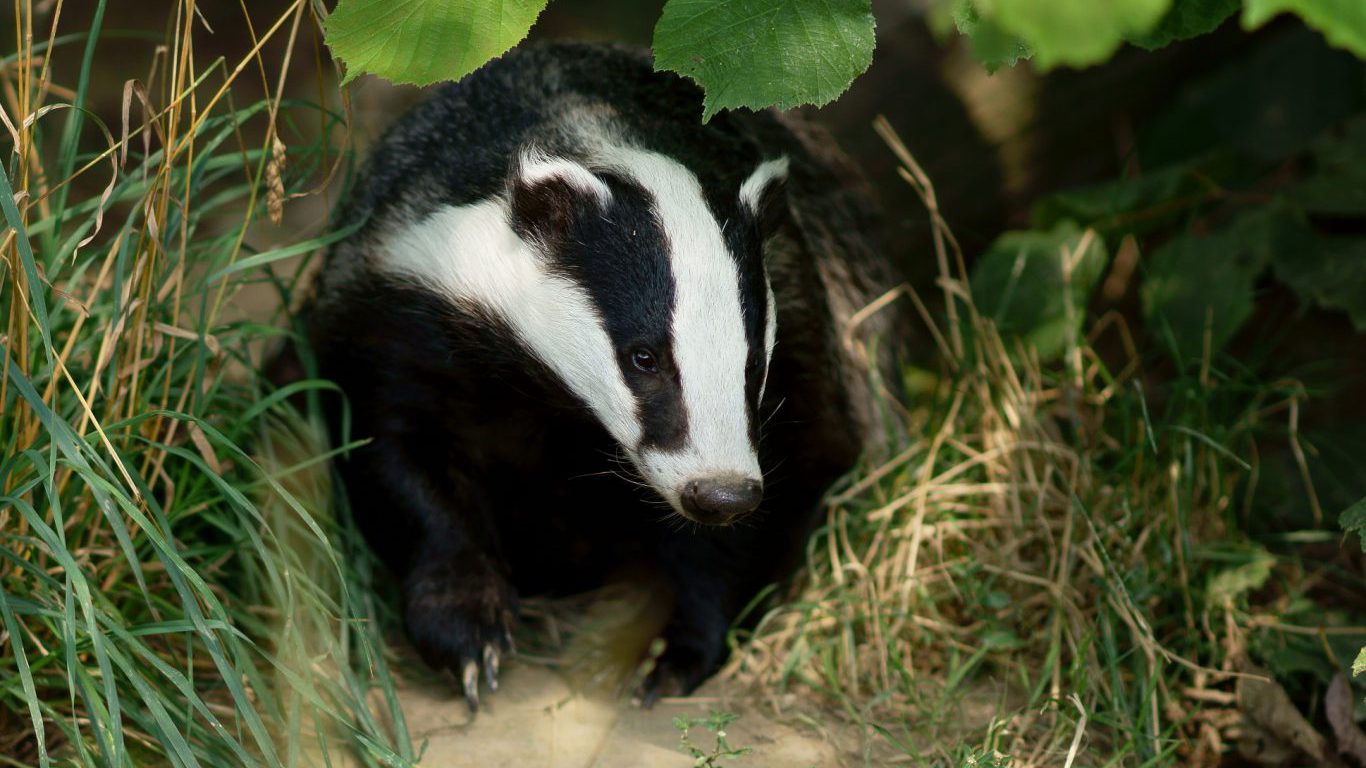
America is a continent-sized country of extraordinary natural diversity. While the bald eagle is the national bird and the North American bison the national mammal, each state has chosen different animals as symbols, reflecting the nation’s diversity.
State animals include cats that weigh a few pounds and whales that weigh tens of tons, dogs that are loyal and loving and bears that are carnivorous, panthers that number in the low hundreds and birds that number in the millions. 24/7 Tempo identified the official pets and animals of every state and considered how they were selected.
The tradition dates back more than a century. The 1893 World’s Fair in Chicago featured a “National Garland of Flowers” with representative flowers from each state. This began a trend that led to the adoption of state animals and other symbols. Some were designated by state legislatures, while others were chosen by polling certain groups, such as school children, teachers, and sportsmen.
At times, the selection process has been contentious. An effort to make the golden retriever the official dog of Georgia in 1991 was foiled in the state Senate by a campaign in favor of the bulldog, the mascot of the University of Georgia. A bill to make the Labrador retriever the official dog of Maine was defeated, although the state does have an official cat, the Maine coon cat.
Unfortunately, many of the wild animals that serve as state symbols have declined in numbers over the years and quite a few are endangered. These are the most threatened wildlife in every state.
In the past, some were almost hunted to extinction. Even when protected by legislation, these state symbols still face threats such as habitat loss, collisions with vehicles, predation, disease, and climate change. Some states are more dangerous for animals because of abuse, neglect, and abandonment.
Click here to see the official pets and animals of every state

1. Alabama
> State pet: N/A
> State mammal(s): Black bear, West Indian manatee, racking horse
> State bird: Northern flicker, eastern wild turkey, willow ptarmigan
> State fish and aquatic life: Largemouth bass, brown shrimp, fighting tarpon
The black bear was designated the official state mammal of Alabama in 1996. The population is small and is concentrated in just two areas, but it has been increasing in recent years. Black bears are omnivores and will eat nuts, berries, insects, and small mammals. They are much smaller than grizzlies — the average weight for males is 150 to 350 pounds and for females is 120 to 250 pounds.
[in-text-ad]
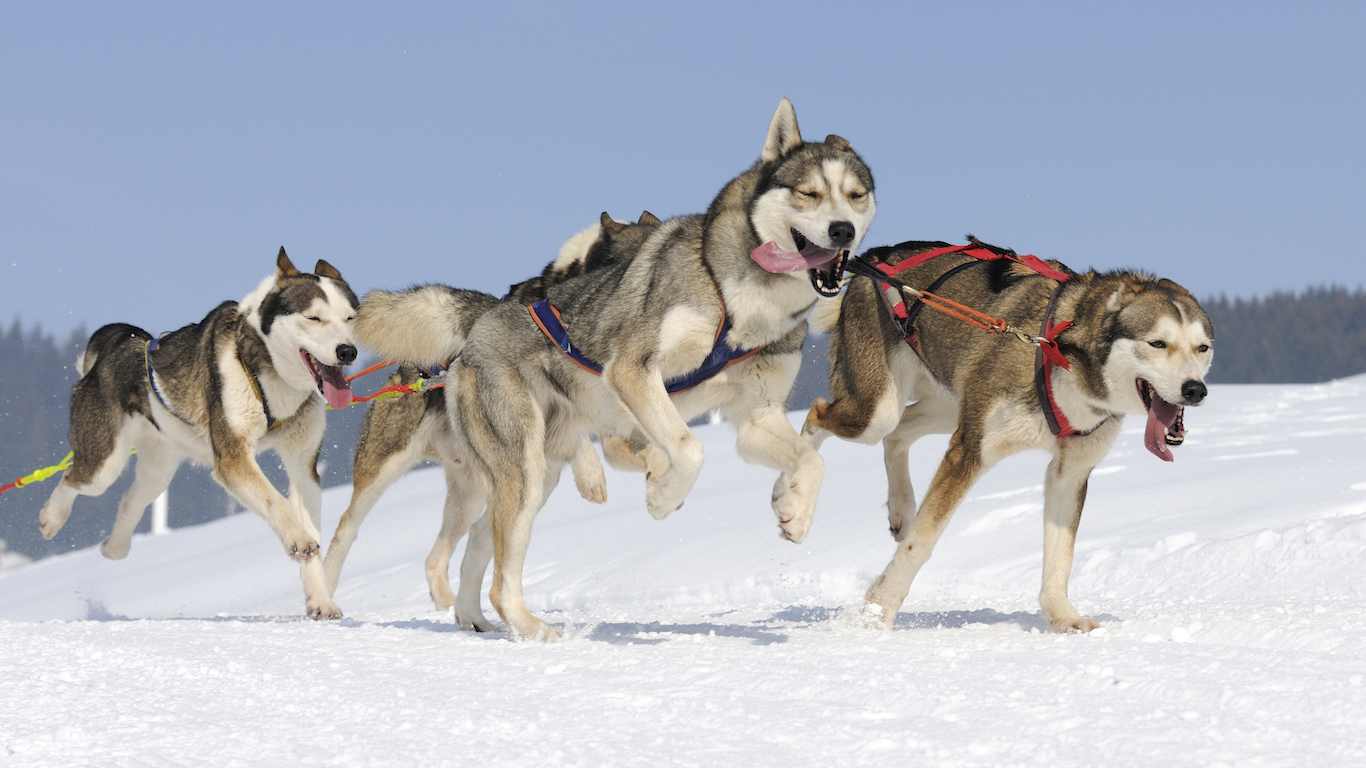
2. Alaska
> State pet: Alaskan malamute
> State mammal(s): Moose, bowhead whale
> State bird: N/A
> State fish and aquatic life: Bowhead whale, king salmon
The Alaskan malamute is named after the Mahlemut people of Alaska, a native Inuit tribe whose remoteness helped preserve the purity of this ancient dog breed. Malamutes are true working dogs and have been used to pull sleds, hunt seals, and protect people from bears. They have great strength and stamina and can endure the harshest conditions. They are also friendly and loyal and make great pets.

3. Arizona
> State pet: N/A
> State mammal(s): Ringtail
> State bird: Cactus wren
> State fish and aquatic life: Apache trout
The ringtail became the official state mammal of Arizona in 1986. Although it is called a cat, the ringtail is related to the raccoon and coatimundi and looks like a fox with a striped tail. It is nocturnal and sleeps for most of the day. It can be tamed and kept as a pet and has been used to keep homes free of vermin.

4. Arkansas
> State pet: N/A
> State mammal(s): White-tailed deer
> State bird: Mockingbird
> State fish and aquatic life: N/A
The white-tailed deer has become the official state mammal of 11 states, including Arkansas in 1993. Deer were very plentiful in Arkansas before European settlement, but they were hunted nearly to extinction after. The Arkansas Game and Fish Commission established the state’s first deer season in 1916 and created deer refuges in the 1920s. The Arkansas deer population has recovered to more than a million in recent years.
[in-text-ad-2]

5. California
> State pet: Shelter pet
> State mammal(s): Gray whale and California grizzly bear
> State bird: California quail
> State fish and aquatic life: Gray whale, california golden trout and Garibaldi
The grey whale was designated the official state marine mammal of California in 1975. Gray whales have among the longest migrations of any mammal. They spend the summer in the Bering Sea and then travel as much as 7,000 miles to Baja, California, where they mate, before heading back north in the spring. Since they swim close to shore, whale watching has become very popular with tourists. Grey whales were almost hunted to extinction in the 19th and early 20th centuries but recovered because of legal protection. They were removed from the endangered species list in 1994. Unfortunately, they are now threatened by global warming and rising sea temperatures.
6. Colorado
> State pet: Shelter dogs and cats
> State mammal(s): Rocky Mountain bighorn sheep
> State bird: Lark bunting
> State fish and aquatic life: Greenback cutthroat trout
The Rocky Mountain bighorn sheep became the official state animal of Colorado in 1961. As the name suggests, it has enormous horns, which can grow to more than 4 feet in length, and it is found only in the Rockies. Rams live in all-male groups, and females live with other females and their young. Rams use their horns as weapons to fight for dominance or mating rights and are protected from injury by thick skulls.
[in-text-ad]

7. Connecticut
> State pet: N/A
> State mammal(s): Sperm whale
> State bird: American robin
> State fish and aquatic life: Sperm whale, eastern oyster, American shad
The sperm whale became the official state mammal of Connecticut in 1975. Connecticut used to be a center of the whaling industry, but sperm whales were almost hunted to extinction and are now on the endangered species list. They are the largest of the toothed whales and grow up to 70 feet long. Herman Melville’s novel Moby Diсk was based on a true story of a sperm whale that attacked and sank a whaleship.

8. Delaware
> State pet: Golden retriever
> State mammal(s): Grey fox
> State bird: Blue hen chicken
> State fish and aquatic life: Channeled whelk, horseshoe crab, weakfish
The golden retriever isn’t just popular in Delaware — it’s the third most popular dog breed in the country, according to the American Kennel Club. Golden retrievers are smart and have a great work ethic. They are often used as guide dogs, in search and rescue, and – as their name suggests – for hunting. Their many other endearing characteristics, including patience and playfulness, make them great pets.

9. Florida
> State pet: N/A
> State mammal(s): Florida panther, dolphin, manatee
> State bird: Mockingbird
> State fish and aquatic life: Horse conch, Atlantic sailfish, largemouth bass
The Florida panther is a unique subspecies of cougar that became the official state mammal in 1982. There were as few as 20 Florida panthers in the wild in the 1970s, but once added to the state’s endangered species list, the population recovered to an estimated 120 to 230 in 2017. They still face many threats, ranging from habitat loss to collisions with vehicles to inbreeding. They also have a natural predator, the alligator, an animal commonly found throughout the state.
[in-text-ad-2]
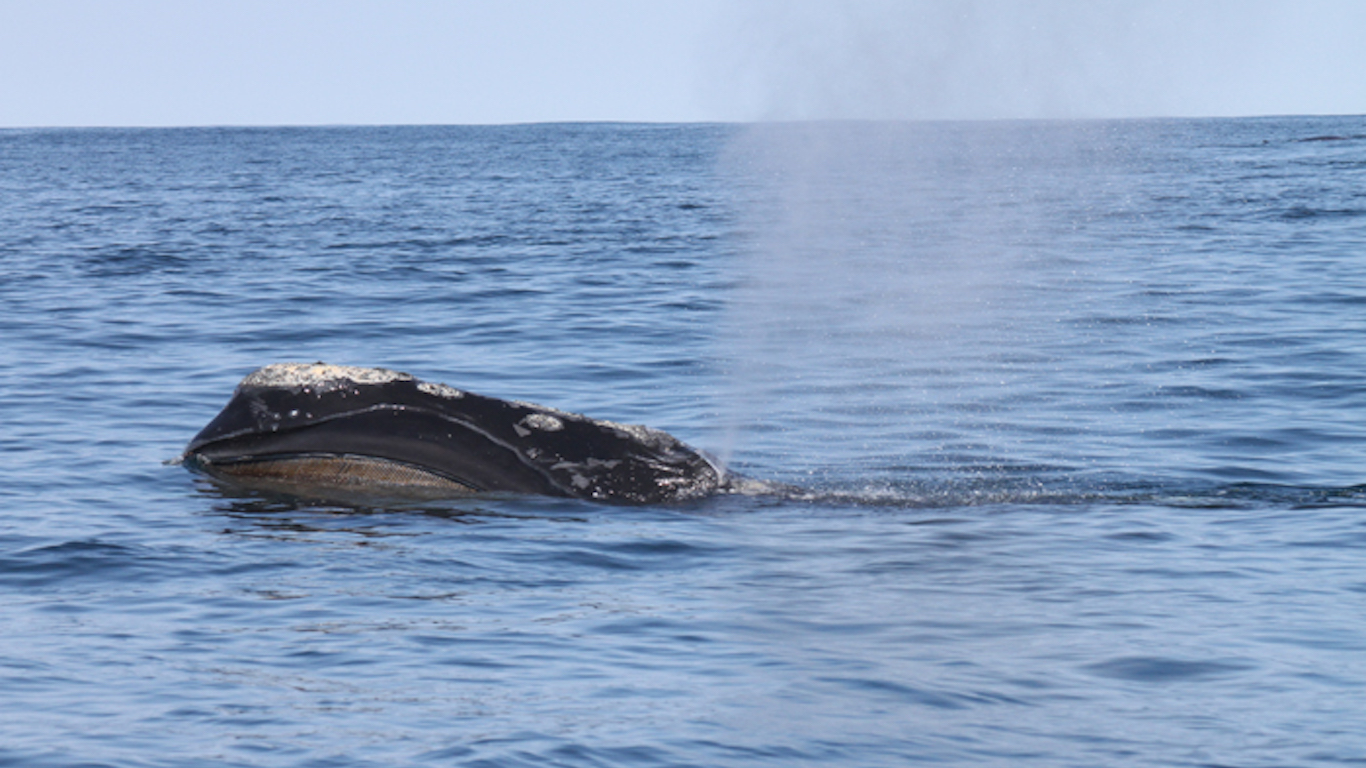
10. Georgia
> State pet: Shelter dog
> State mammal(s): Right whale, white-tailed deer
> State bird: Brown thrasher
> State fish and aquatic life: Largemouth bass
The northern right whale is the only great whale native to Georgia waters, and it has been the official state marine mammal since 1985. Unfortunately, its name was given by whalers who viewed it as the easiest whale to hunt, as it swims slowly, close to the surface and floats when killed. Hunting the northern right whale has been banned for many years, but the population is not increasing.
The Georgia state legislature passed in 2016 Senate Bill 168, making shelter dogs the state’s official pet.

11. Hawaii
> State pet: N/A
> State mammal(s): Hawaiian monk seal, humpback whale, Hawaiian hoary bat
> State bird: Nene (the Hawaiian goose)
> State fish and aquatic life: Humuhumunukunukuapua`a
The Hawaiian monk seal was designated an official state mammal in 2008. Most seals live in frigid waters, but the Hawaiian monk seal has adapted to the state’s warm tropical waters. It feeds on spiny lobsters, octopuses, and eels during the night and basks in the sun during the day. It faces a range of threats, including habitat loss and shark attacks. The morbillivirus has killed tens of thousands of seals in Europe, so the National Oceanic and Atmospheric Administration launched a vaccination program for the Hawaiian monk seal.
[in-text-ad]

12. Idaho
> State pet: N/A
> State mammal(s): Appaloosa horse
> State bird: Peregrine falcon and mountain bluebird
> State fish and aquatic life: Cutthroat trout
The Appaloosa has been the official state horse of Idaho since 1975, and it’s very popular there. Idaho boasts an Appaloosa Museum & Heritage Center, an Appaloosa Horse Club, which serves as an international breed registry, an Appaloosa Youth Association, and even a custom license plate that features the Appaloosa. It is one of the most recognizable horse breeds, with its colorful spotting pattern, mottled skin, and striped hooves.

13. Illinois
> State pet: Shelter dogs and cats
> State mammal(s): White-tailed deer
> State bird: Northern cardinal
> State fish and aquatic life: Bluegill
The bluegill has been the official state fish of Illinois since 1986. It is a member of the sunfish family and lives in streams, rivers, lakes, and ponds all over the state. It plays an important role in habitat management as it is omnivorous and helps keep crustacean and insect populations under control. The bluegill can be kept as a pet, but it can grow to more than 10 inches in length and needs a large tank.
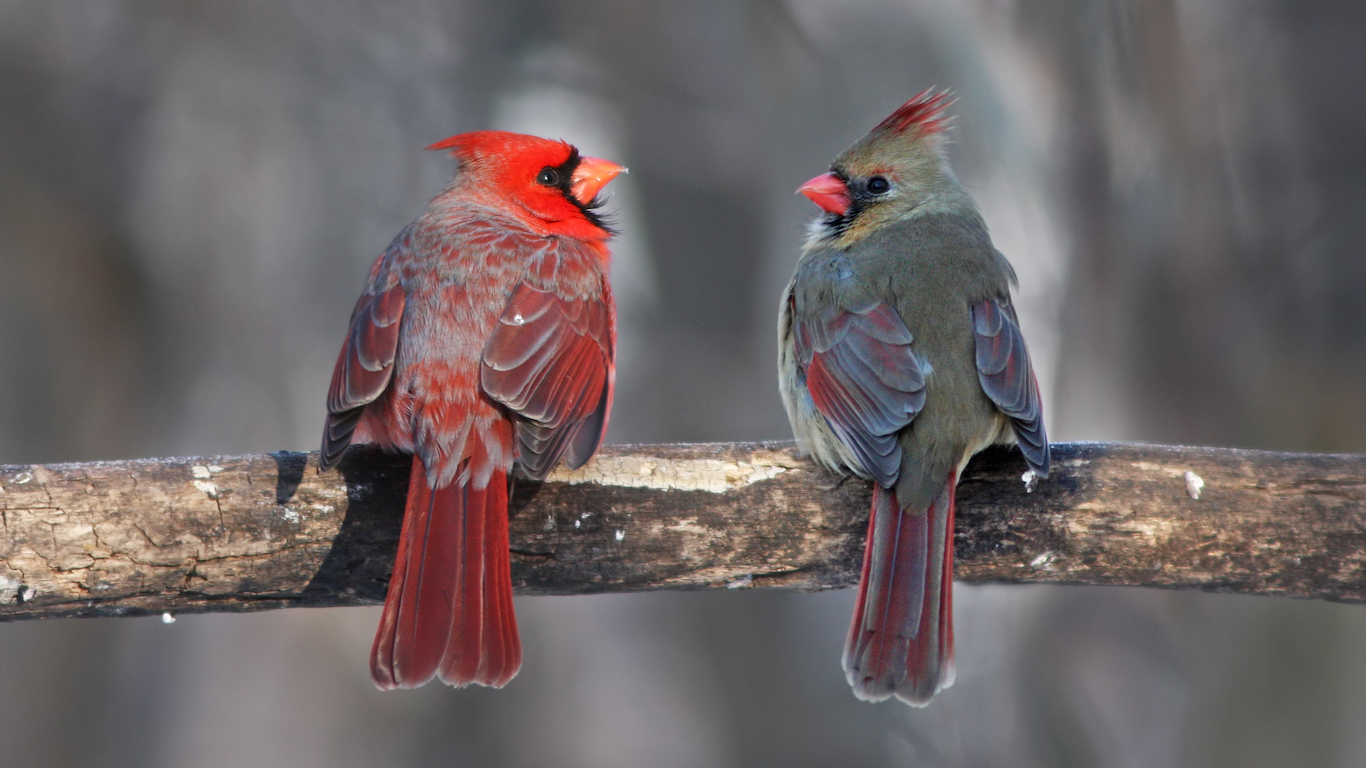
14. Indiana
> State pet: N/A
> State mammal(s): N/A
> State bird: Cardinal
> State fish and aquatic life: N/A
Indiana is one of seven states to name the cardinal as its official state bird. Named made the northern , one of seven states to do so. Male cardinals are known for their brilliant red color. Cardinals breed two to three times a season, and their populations are healthy. The cardinal was officially adopted as the Indiana state bird in 1933.
[in-text-ad-2]

15. Iowa
> State pet: N/A
> State mammal(s): N/A
> State bird: Eastern goldfinch
> State fish and aquatic life: N/A
Found all over the state, the eastern goldfinch has been the official bird of Iowa since 1933. Adult males have bright yellow bodies and black wings, while females have more muted colors. They are active and acrobatic birds and often make a contact call while flying. This has been described as sounding like po-ta-to-chip!
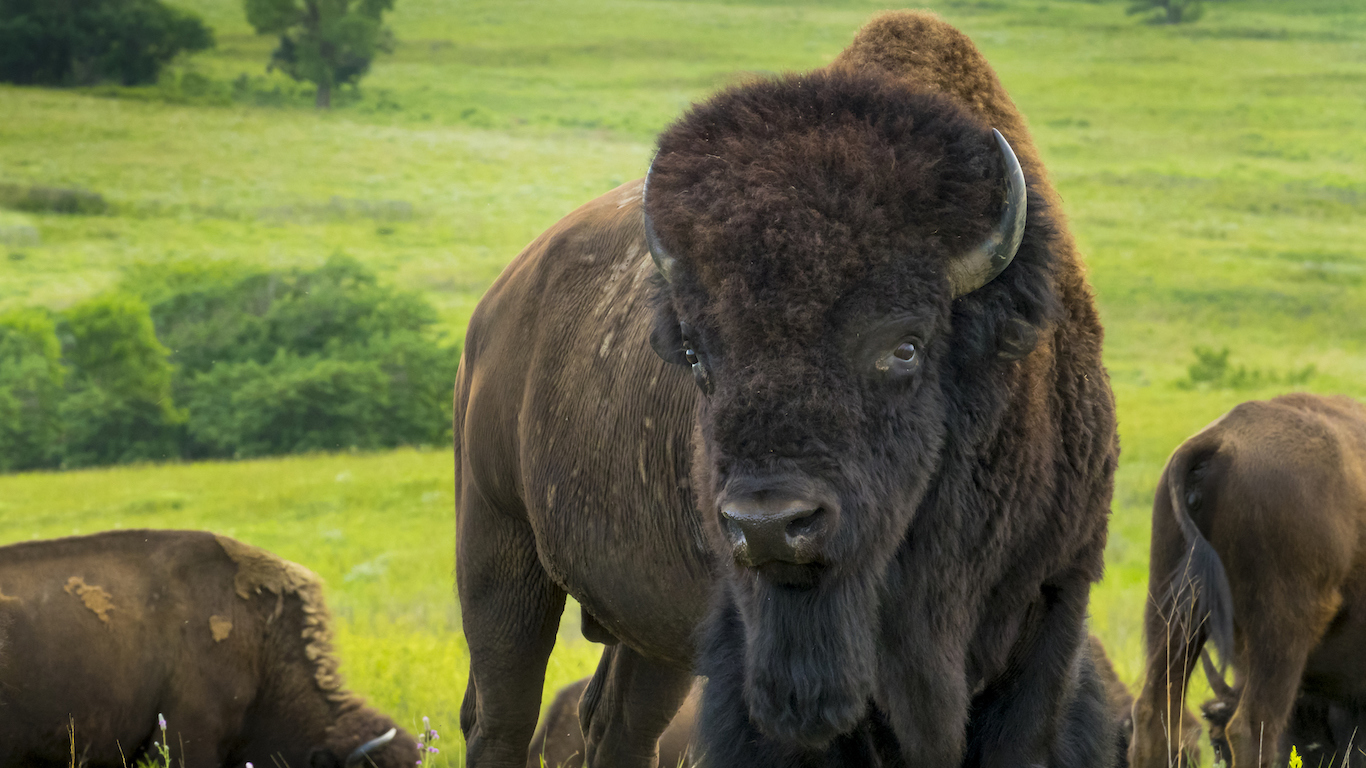
16. Kansas
> State pet: N/A
> State mammal(s): American buffalo
> State bird: Western meadowlark
> State fish and aquatic life: N/A
The American buffalo, also known as the bison, has been the official state animal of Kansas since 1955. The animal’s likeness appears on the state flag, seal and on the U.S. Mint’s commemorative Kansas quarter. American buffalo were almost hunted to extinction by European settlers in the 19th century. Their numbers have rebounded, but they still face threats from habitat loss and disease.
The American buffalo became the official national mammal in 2016 and has been used as symbol or mascot by colleges and universities and government bodies around the country.
[in-text-ad]
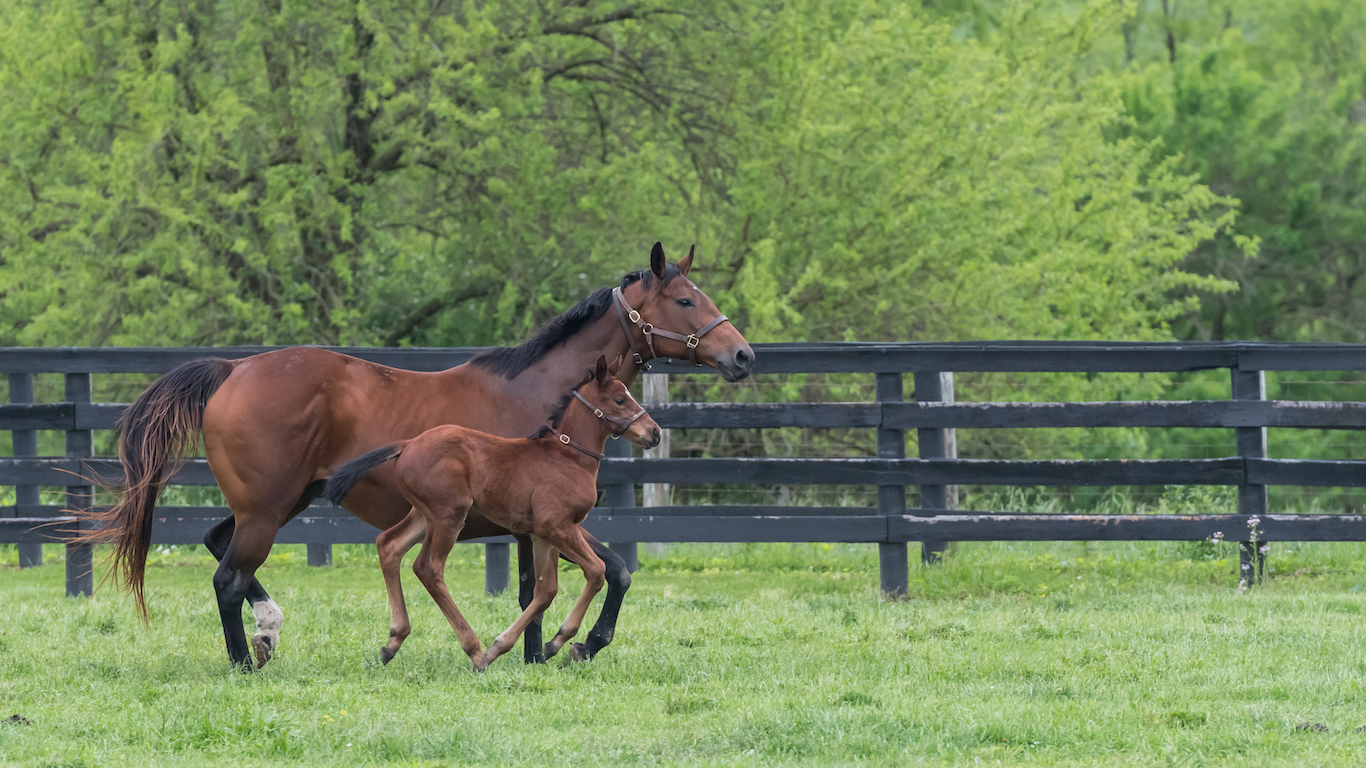
17. Kentucky
> State pet: N/A
> State mammal(s): Thoroughbred horse, grey squirrel
> State bird: Northern cardinal
> State fish and aquatic life: Kentucky spotted bass
The thoroughbred has been the official state horse of Kentucky since 1996. That’s not surprising as Kentucky is synonymous with horse breeding and racing. It’s home to the famous Kentucky Derby, the longest continuously held sporting event in America and one of the most prestigious horse races in the world. All thoroughbreds are descended from three Arabian horses imported to England in the 1700s: the Byerly Turk, the Darley Arabian, and the Godolphin Arabian.
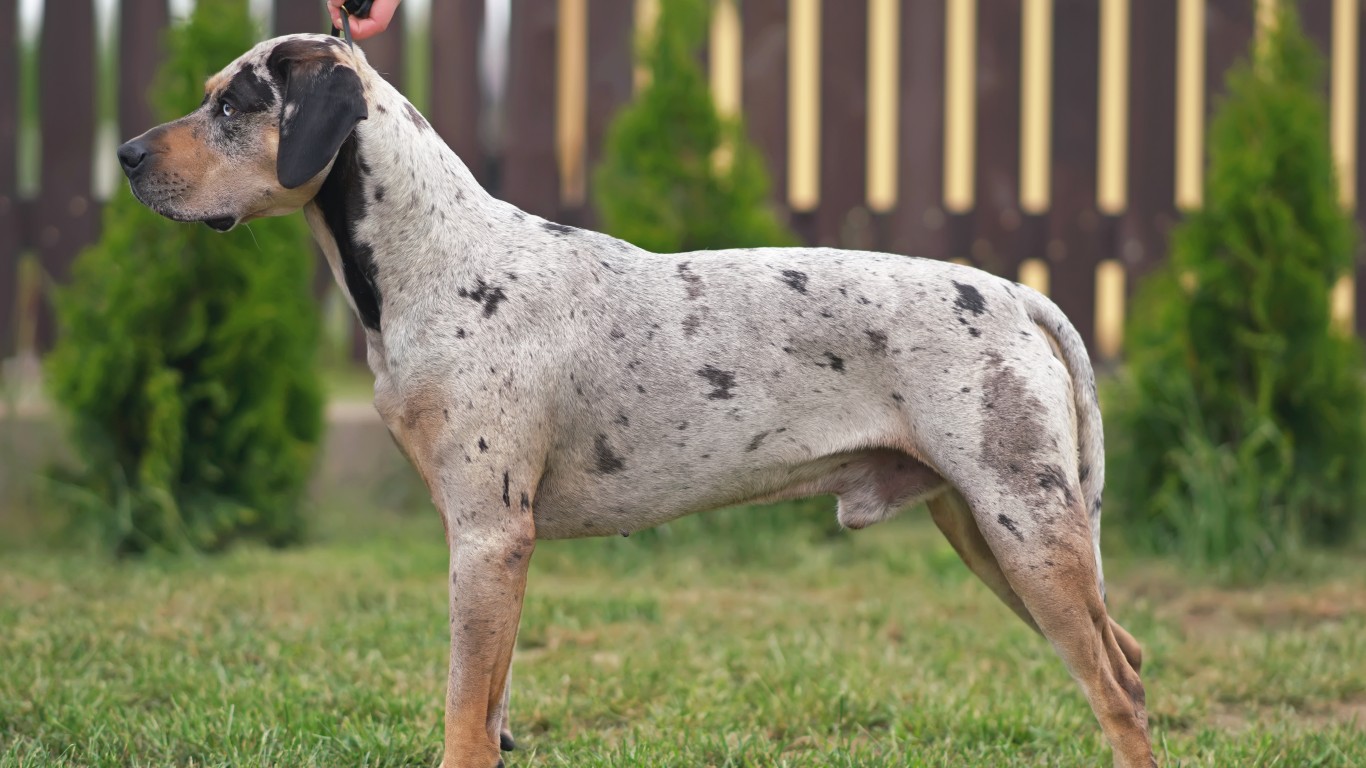
18. Louisiana
> State pet: Catahoula leopard dog
> State mammal(s): Black bear
> State bird: Eastern brown pelican
> State fish and aquatic life: Crawfish, white perch
The Catahoula leopard dog is the only breed of dog to have originated in Louisiana, so it’s not surprising that it’s also the state pet. Catahoula is a Choctaw word that means “sacred lake.” Catahoulas are the largest and most aggressive of the cattle dogs and were traditionally used to herd wild cattle and hogs. It’s common for Catahoulas to have eyes of different colors.

19. Maine
> State pet: Maine coon cat
> State mammal(s): Moose
> State bird: Chickadee
> State fish and aquatic life: Landlocked salmon, lobster
The Maine coon cat, one of the oldest natural breeds in America, was designated the official state cat of Maine in 1985. The cats are well adapted for Maine’s tough winters, with thick coats, bushy tails, furry ears, and large feet that effectively function as snow shoes. They are also very big, and can weigh as much as 25 pounds. Maine coons were cast for the role of Mrs. Norris, the pet owned by Hogwarts caretaker Argus Filch, in the Harry Potter films.
[in-text-ad-2]
20. Maryland
> State pet: Calico cat, Chesapeake Bay retriever
> State mammal(s): Thoroughbred horse, right whale
> State bird: Baltimore oriole
> State fish and aquatic life: Blue Crab, Rockfish
The calico cat became the official cat of Maryland in 2001. Calico is not a breed of cat but denotes a tri-color pattern, usually orange, black, and white, found in different breeds. The colors are determined genetically by the X chromosome, and thus calico cats are almost always female because males only have one X chromosome. The calico’s colors are shared with the state bird, the Baltimore oriole, and the state insect, the Baltimore checkerspot butterfly.
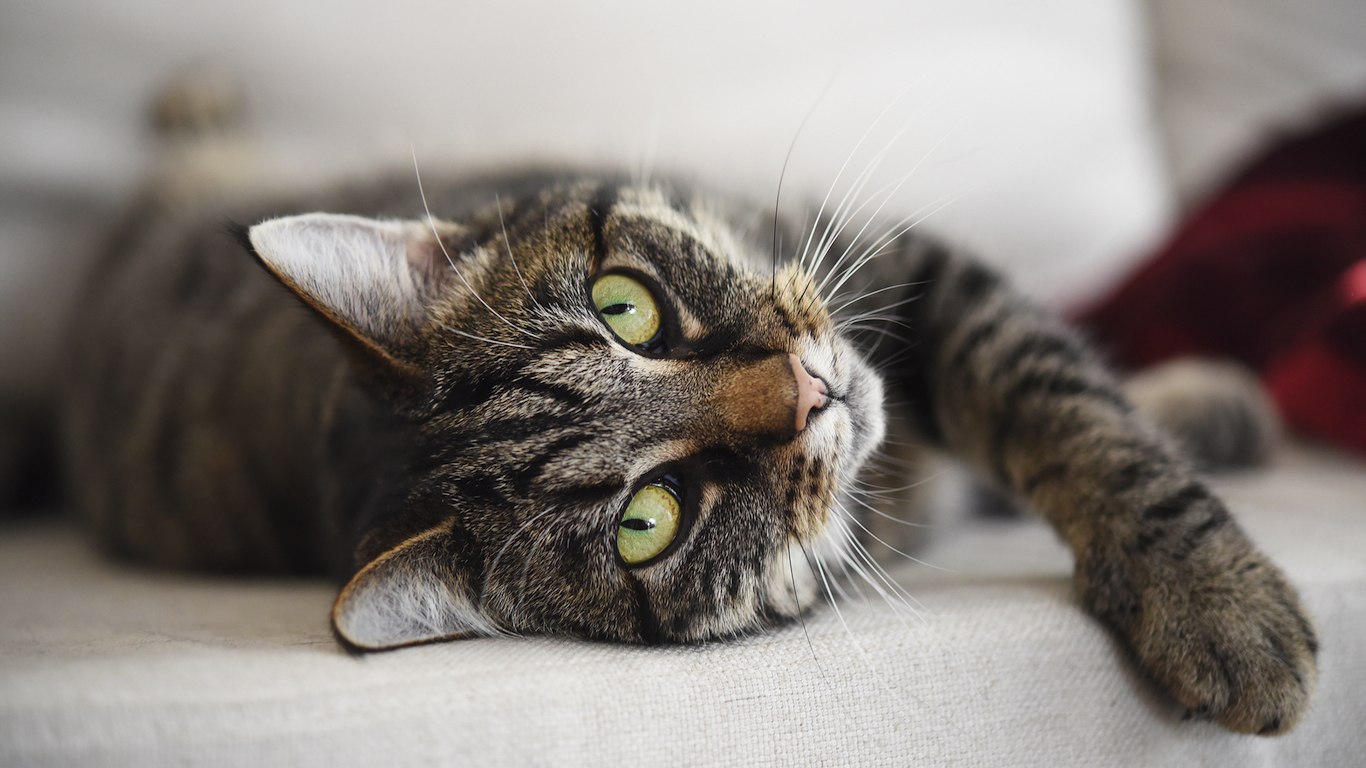
21. Massachusetts
> State pet: Tabby cat, Boston terrier
> State mammal(s): Morgan horse
> State bird: Chickadee, wild turkey
> State fish and aquatic life: Cod, right whale
The tabby cat was designated the official state cat in 1988 at the suggestion of the schoolchildren of Massachusetts. As with the calico, “tabby” denotes a color pattern, not a breed. The Boston terrier became the official state dog in 1979. It is a U.S. breed, the result of a cross between an English bulldog and a white English terrier. It has been a popular pet for more than a century.
[in-text-ad]

22. Michigan
> State pet: N/A
> State mammal(s): White-tailed deer
> State bird: Robin redbreast
> State fish and aquatic life: Brook trout
The white-tailed deer was designated the official game mammal of Michigan in 1997. There were an estimated 1.75 million deer in the state in 2017. The population fluctuates depending on the harshness of the winter and the number harvested in a hunting season. The white-tailed deer is quite an athlete and can run at about 40 miles an hour and clear fences as high as nine feet.
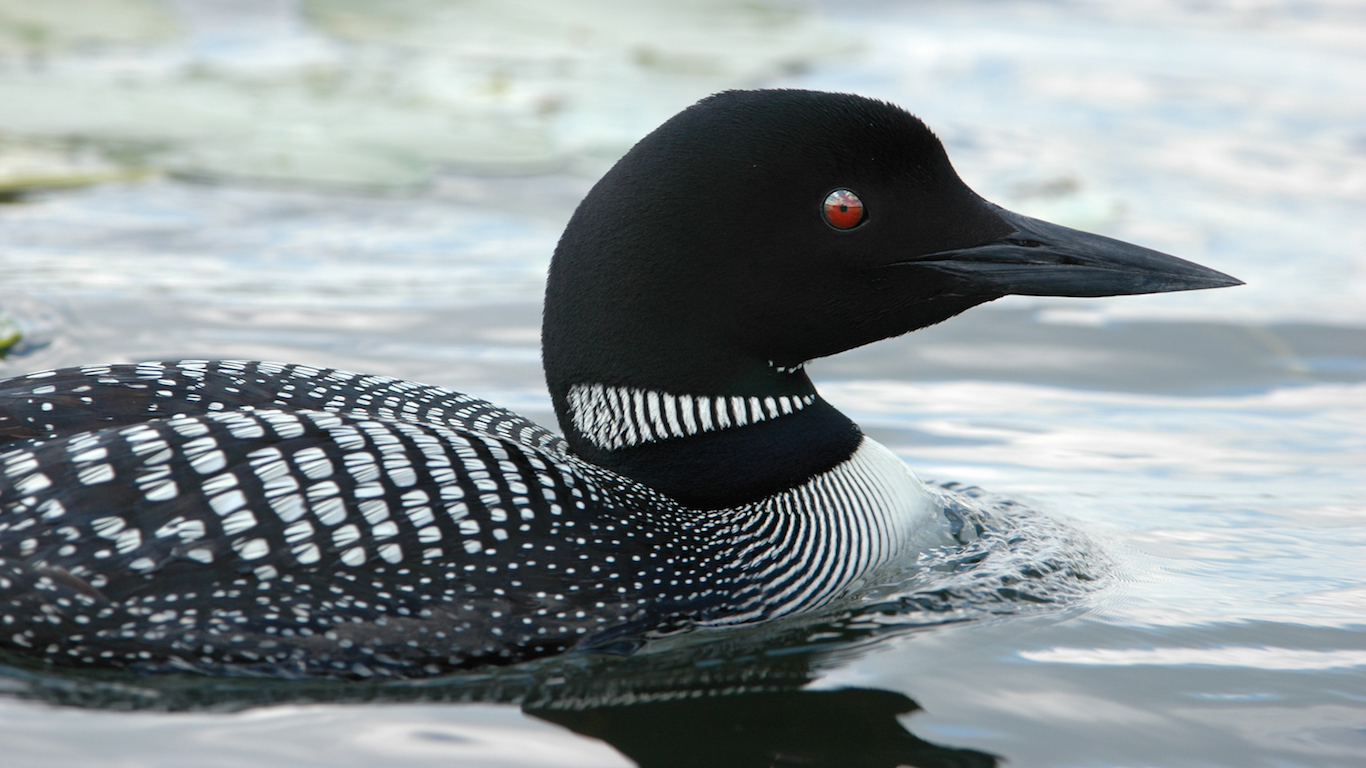
23. Minnesota
> State pet: N/A
> State mammal(s): N/A
> State bird: Loon
> State fish and aquatic life: Walleye
Minnesota designated the common loon as the official state bird in 1961. It has more common loons than any state except for Alaska. The loons live on lakes in central and northeastern Minnesota and migrate to warmer climates along the Atlantic coast and the Gulf of Mexico for the winter. Loons are also fast underwater swimmers and can dive as deep as 90 feet.
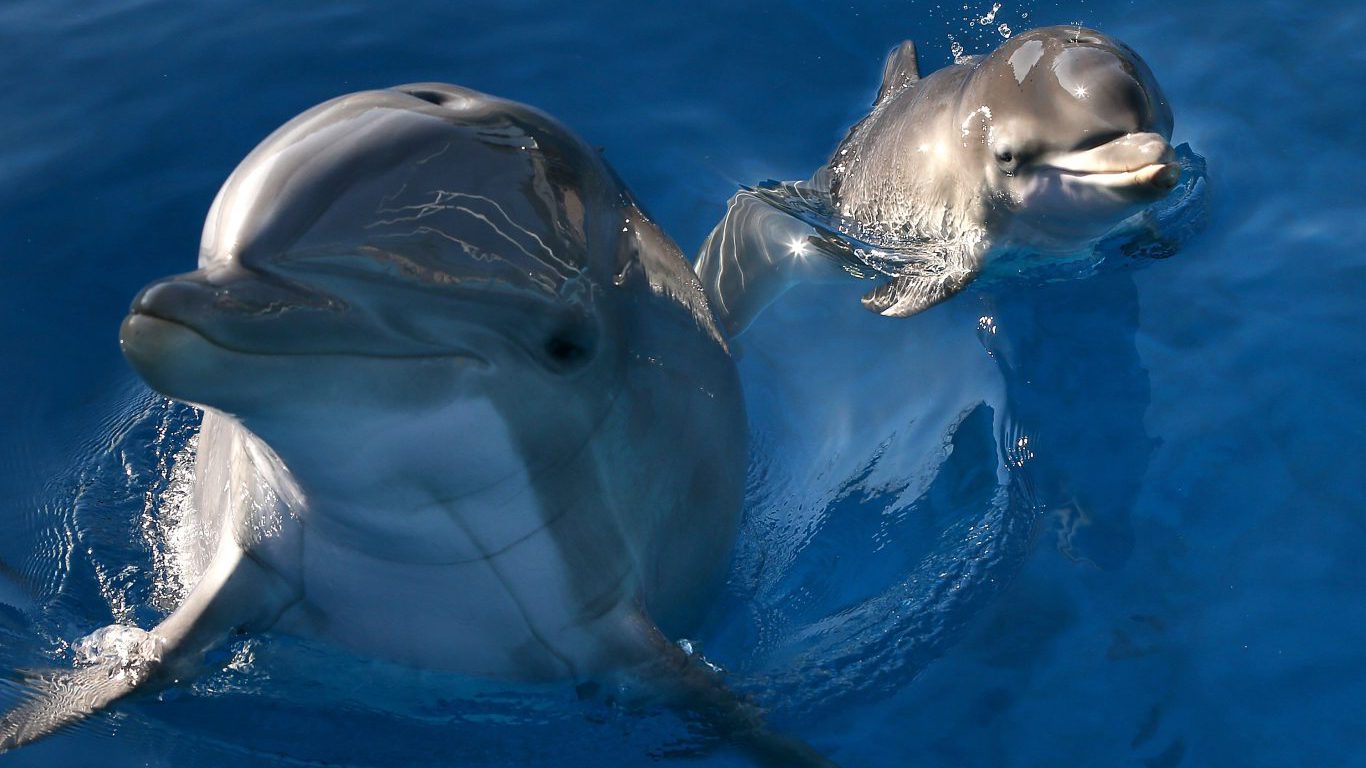
24. Mississippi
> State pet: N/A
> State mammal(s): Porpoise
> State bird: Wood duck, mockingbird
> State fish and aquatic life: Largemouth bass
Mississippi designated the bottlenose dolphin, or porpoise, which is common along the Gulf Coast, as the official state water mammal in 1974. Bottlenose dolphins are intelligent and playful and have featured in films, television shows, video games, and novels. Flipper, the subject of the 1960s TV series, was a bottlenose dolphin.
[in-text-ad-2]

25. Missouri
> State pet: N/A
> State mammal(s): Missouri fox trotting horse, Missouri mule
> State bird: Bluebird, bobwhite quail
> State fish and aquatic life: Paddlefish, crayfish, channel catfish
The Missouri mule was designated an official state animal in 1995. Mules have long been used to pull wagons and carry cargo, and Missouri was the main provider of mules for decades. They are very strong and rugged and can go places vehicles can’t. In fact, the U.S. Army had mule units as recently as 1957. Mules are the offspring of a female horse and a male donkey and cannot breed themselves.
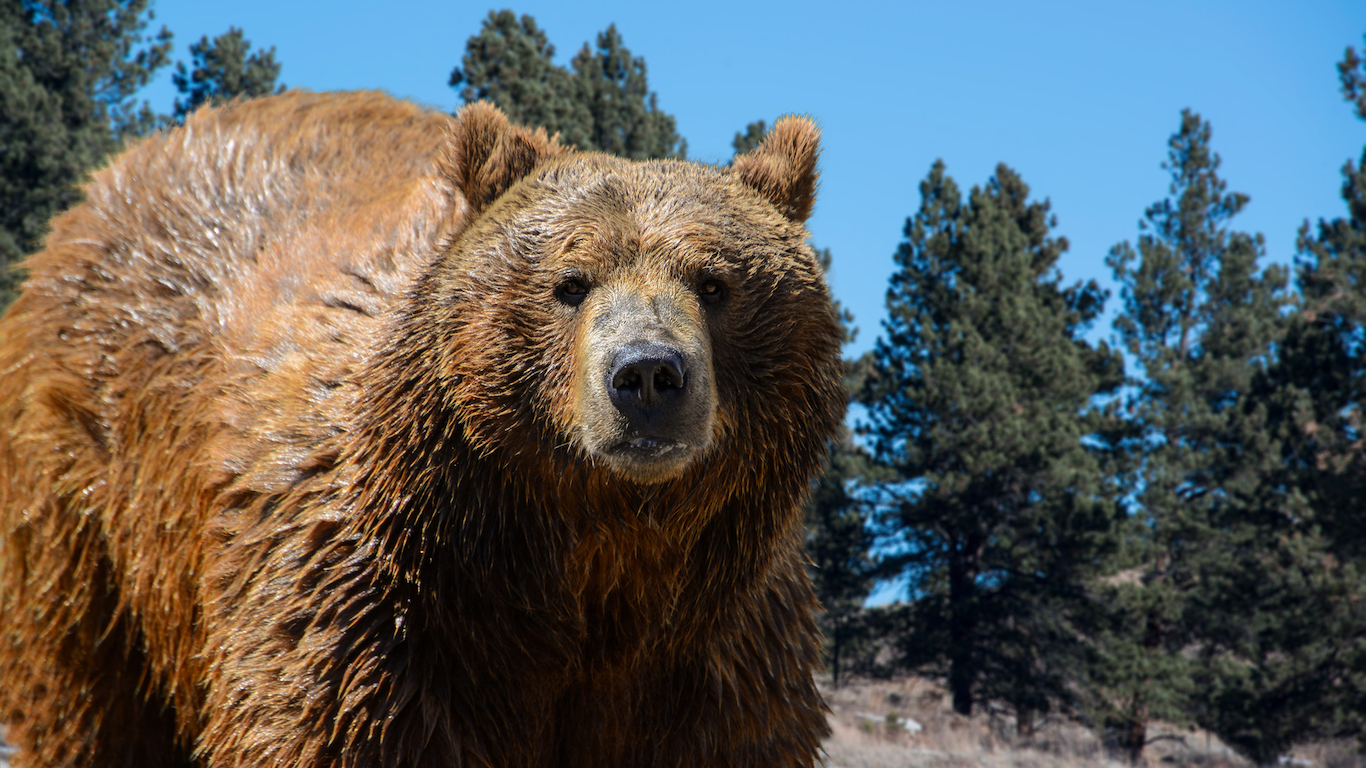
26. Montana
> State pet: N/A
> State mammal(s): Grizzly bear
> State bird: Western meadowlark
> State fish and aquatic life: Black-spotted cutthroat trout
The grizzly is the largest carnivore in America and can weigh up to 1,500 pounds. It became the official state animal of Montana in 1983, having beaten out 73 other animals in elections run by schoolchildren. In 2017, the United States Fish & Wildlife Service removed the population of grizzly bears in Yellowstone National Park, which extends from Wyoming into Montana, from the threatened species list.
[in-text-ad]

27. Nebraska
> State pet: N/A
> State mammal(s): White-tailed deer
> State bird: Western meadowlark
> State fish and aquatic life: Channel catfish
The western meadowlark was designated the official state bird of Nebraska in 1929. It is in the same family as the yellow-headed blackbird and is about the same size as a robin. It has a yellow throat and breast with a characteristic black “V.”
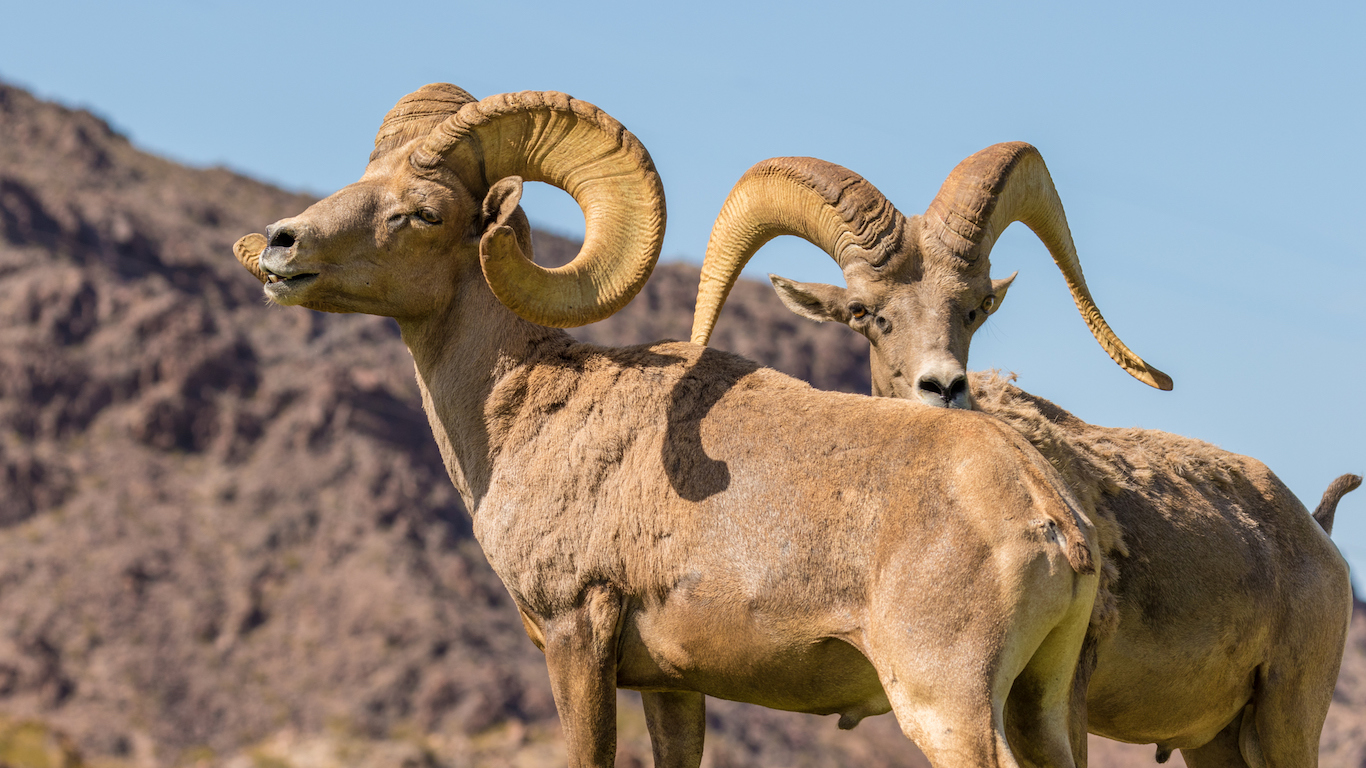
28. Nevada
> State pet: N/A
> State mammal(s): Desert bighorn sheep
> State bird: Mountain bluebird
> State fish and aquatic life: Lahontan cutthroat trout
The desert bighorn sheep has been the official state animal of Nevada since 1973. As its name suggests, the desert bighorn sheep is distinguished by its large horns, which grow throughout its life. Both males and females have horns, although the males’ are bigger and more curved. They are well adapted to the desert environment and can go for long periods without water, but they are nevertheless an endangered species.
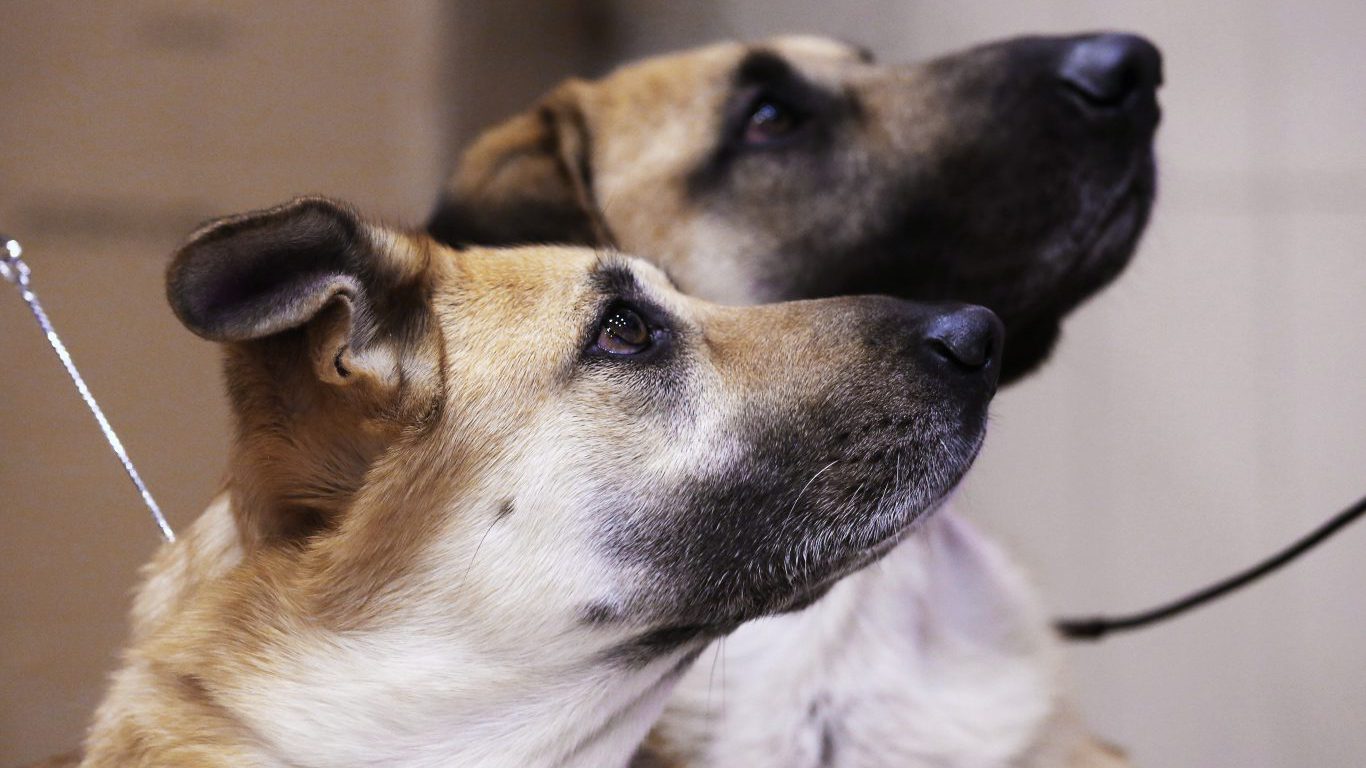
29. New Hampshire
> State pet: Chinook
> State mammal(s): White-tailed deer and bobcat
> State bird: Purple finch
> State fish and aquatic life: Brook trout and striped bass
The Chinook is the only dog breed that originated in New Hampshire. It became the official state dog in 2009. The Chinook was developed by Arthur Walden, a New Hampshire native who spent time in Alaska during the Klondike Gold Rush and wanted to breed his own line of sled dogs. A scarce breed, the Chinook is also a great family pet as well as an able working dog.
[in-text-ad-2]
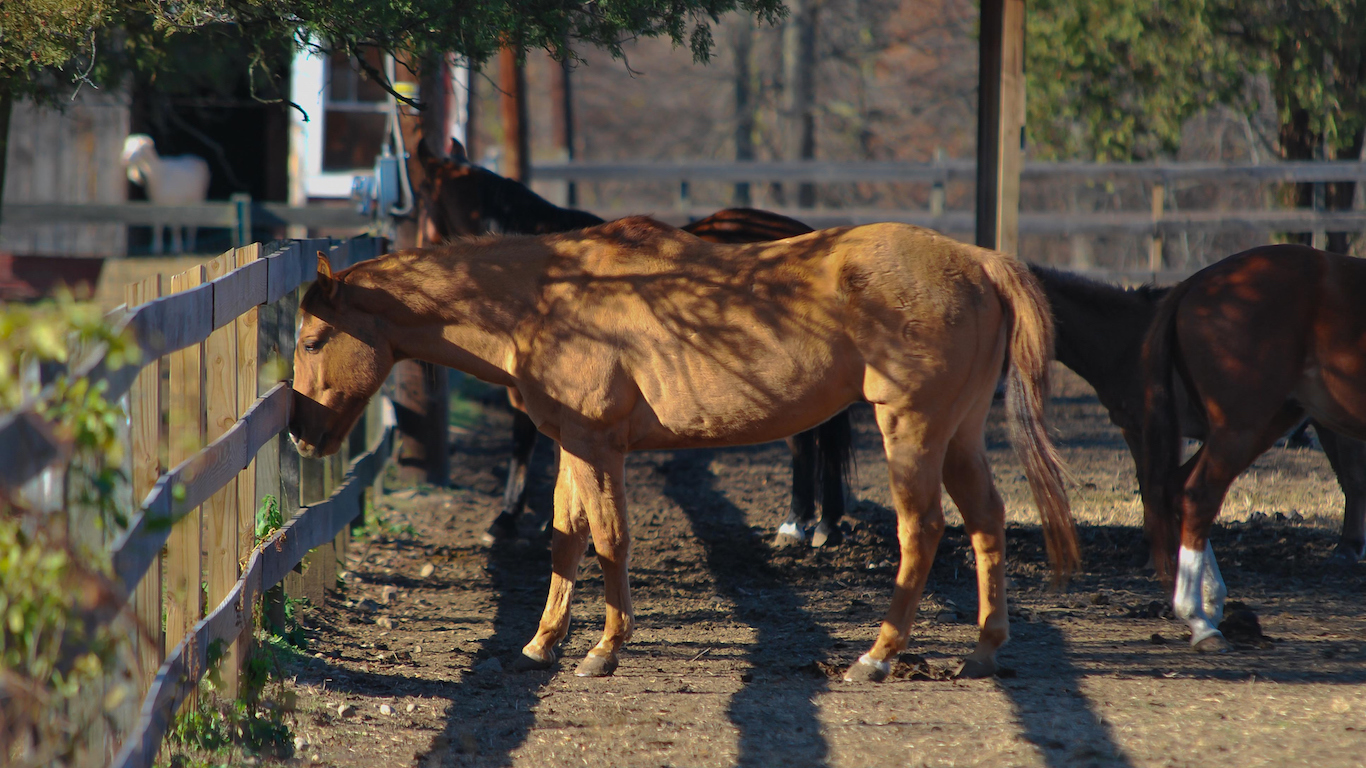
30. New Jersey
> State pet: N/A
> State mammal(s): the horse
> State bird: eastern goldfinch
> State fish and aquatic life: brook trout and knobbed whelk
The horse has been the official animal of New Jersey since 1977. The state’s association with horses goes back a lot farther than that, however. The state seal, which was designed in 1777, features a horse’s head. New Jersey is home to numerous horse farms as well as the United States Equestrian Team Foundation.

31. New Mexico
> State pet: N/A
> State mammal(s): Black bear
> State bird: Greater roadrunner
> State fish and aquatic life: New Mexico cutthroat trout
New Mexico is one of a number of states whose official mammal is the black bear. It also has some other interesting creatures as state symbols. The state bird is the greater roadrunner, which became known to generations of children as the co-star of a series of Looney Tunes and Merrie Melodies cartoons. It prefers running to flying and can manage 15 miles an hour. The state fish is the irresistibly named New Mexico cutthroat trout. This name derives from the fish’s distinctive red, pink, or orange slash-like markings along the throat.
[in-text-ad]

32. New York
> State pet: Working canines
> State mammal(s): Beaver
> State bird: Bluebird
> State fish and aquatic life: Brook trout, striped bass
The beaver became the official state animal of New York in 1975. It was important long before that as a source for the highly lucrative fur trade. Albany, the state capital, was originally named Beverwijck, “district of the beavers.” The beaver is depicted on the Seal of New York City and there is a Beaver Street in the city’s financial district. Known as “nature’s engineer,” the beaver is famous for building dams and is second only to humans in the ability to modify its environment.
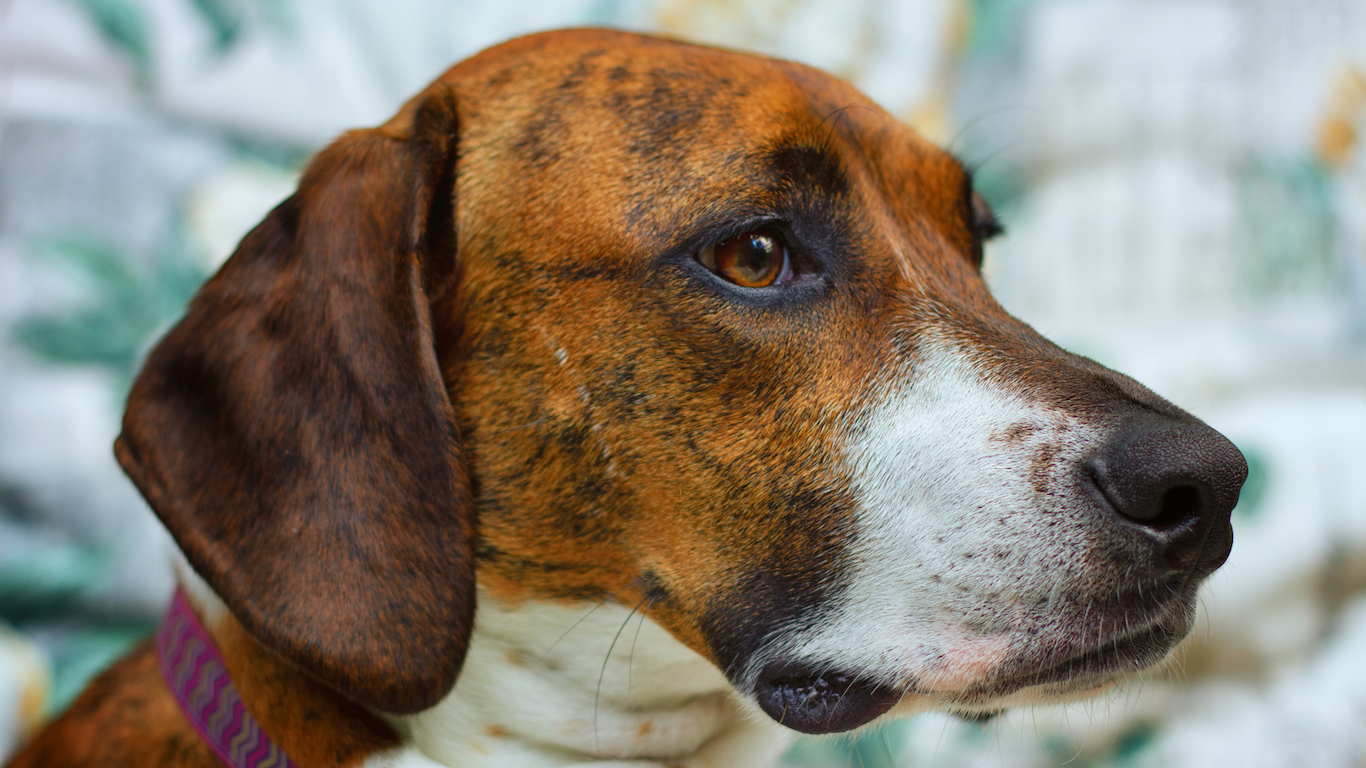
33. North Carolina
> State pet: Plott hound
> State mammal(s): Gray squirrel, Colonial Spanish mustang, Virginia opossum
> State bird: Northern cardinal
> State fish and aquatic life: Southern Appalachian brook trout, Scotch bonnet, channel bass
The Plott hound has been the official state dog of North Carolina since 1989 but was only recognized as a distinctive breed by the American Kennel Club in 1998. It is unique among the six AKC coonhound breeds in that it is descended not from English dogs but from German ones. It originated with Johannes Plott, who brought five Hanover hounds with him when he immigrated from Germany in 1750. The Plott hound makes a great pet and has been described as loving and loyal.

34. North Dakota
> State pet: N/A
> State mammal(s): Nokota horse
> State bird: Western meadowlark
> State fish and aquatic life: Northern pike
The Nokota horse, which became North Dakota’s honorary equine in 1993, has an interesting history. It is descended from the wild horses that lived in the badlands in the southwestern corner of the state. However, the original North American horse went extinct nearly 12,000 years ago, and today’s horses originate from animals introduced by the Spanish. Wild horses can therefore interfere with native wildlife, so when Theodore Roosevelt National Park was created in the 1950s, the National Park Service sought to remove all the horses from it. The NPS does not allow wild horses in its parks and is exempt from legislation that might protect them. Local brothers Leo and Frank Kuntz began buying the horses, and they established the Nokota Horse Conservancy to preserve the breed.
[in-text-ad-2]

35. Ohio
> State pet: N/A
> State mammal(s): White-tailed deer
> State bird: Northern cardinal
> State fish and aquatic life: N/A
Ohio is one of 11 states that have designated the white-tailed deer as their official state animal, and it is one of seven that have chosen the cardinal as their state bird. Many of the animals on our list have declined in numbers over the years, and quite a few are endangered, but the cardinal is one exception. It was actually rare in Ohio in the 18th century because the state was so densely forested. When European settlers cleared the forests they created a more favorable environment for the bird, which likes a mix of woodlands and open plains. Today, cardinals are found throughout the state.
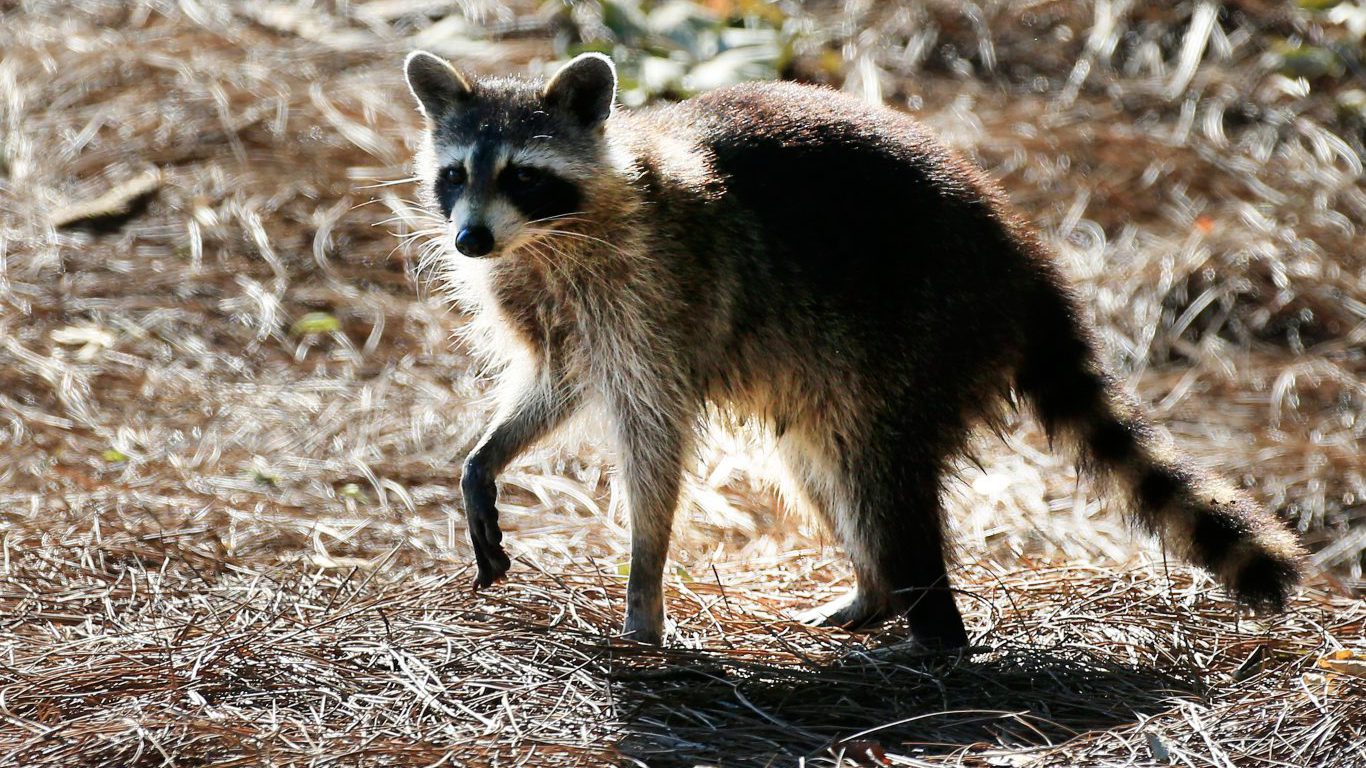
36. Oklahoma
> State pet: N/A
> State mammal(s): Buffalo, raccoon, white-tailed deer, Mexican free-tailed bat
> State bird: Scissor-tailed flycatcher, wild turkey,
> State fish and aquatic life: White bass
The raccoon has been the official fur-bearing animal of Oklahoma since 1989. Oklahoma also has an official state animal, the buffalo; an official game animal, the white-tailed deer; and an official flying mammal, the Mexican free-tailed bat. The raccoon is equally at home in rural and urban areas and will eat almost anything.
[in-text-ad]
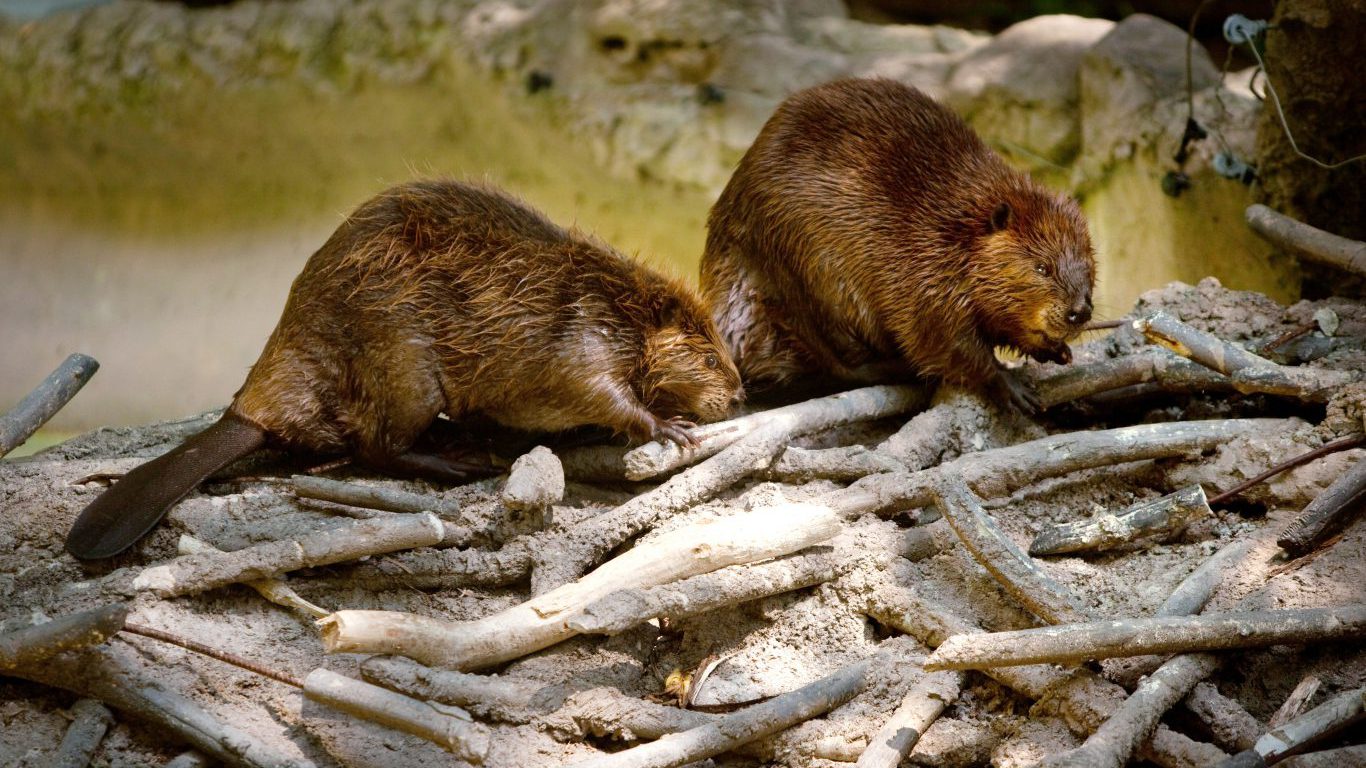
37. Oregon
> State pet: N/A
> State mammal(s): Beaver
> State bird: Western meadowlark
> State fish and aquatic life: Dungeness crab, chinook salmon
Oregon’s official state animal is the beaver, which is no surprise as it’s nicknamed “The Beaver State.” The official state fish is the Chinook, which is the largest of the Pacific salmon. Oregon’s salmon may roam far from their home state. They hatch in freshwater, migrate to the ocean, and eventually return to the stream where they were born to spawn, sometimes covering thousands of miles in the process.

38. Pennsylvania
> State pet: Great Dane
> State mammal(s): White-tailed deer
> State bird: Ruffed grouse
> State fish and aquatic life: Brook trout
Pennsylvania’s official state dog is the Great Dane. It has long been used as a hunting and working dog, and William Penn, after whom the state is named, had one. It’s a big, strong dog — it can be almost 3 feet tall and weigh more than many humans — but is easygoing and makes a great pet. Despite its name, the breed actually originated in Germany, not Denmark.

39. Rhode Island
> State pet: N/A
> State mammal(s): harbor seal
> State bird: Rhode Island Red
> State fish and aquatic life: Striped bass, quahaug, harbor seal
The harbor seal is one of the most recent entrants on our list — it became the official marine mammal of Rhode Island in 2016. Harbor seals are found along the Atlantic Coast from Maine to as far south as North Carolina, but they only breed in the northerly waters. Though it is the smallest state, Rhode Island, nicknamed the Ocean State, has an extensive coastline and numerous harbors.
[in-text-ad-2]
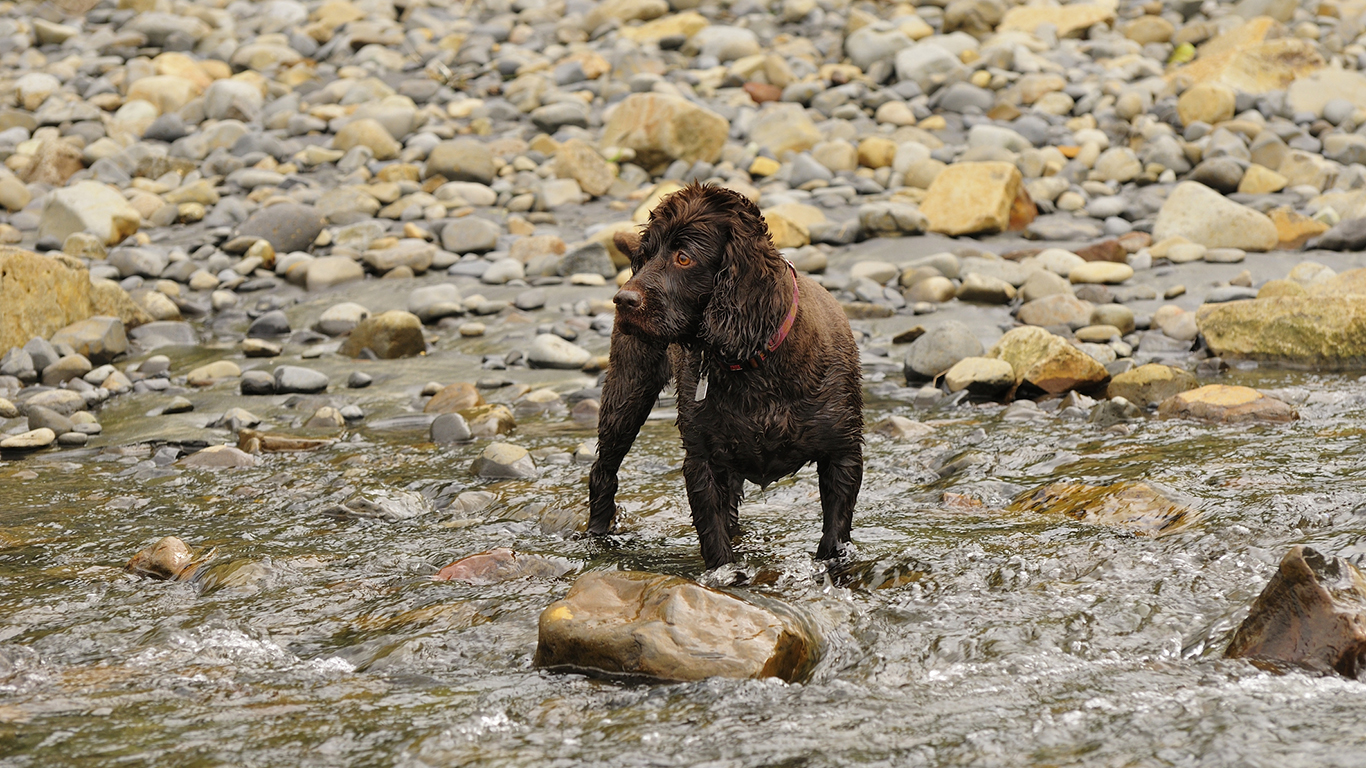
40. South Carolina
> State pet: Boykin spaniel
> State mammal(s): White-tailed deer, mule, bottlenose dolphin
> State bird: Carolina wren, wild turkey, wood duck
> State fish and aquatic life: Striped bass
The Boykin spaniel became the official state animal of South Carolina in 1985. Named after L.W. “Whit” Boykin, it was first bred in the early 1900s to hunt ducks and wild turkeys in the state’s swampy terrain. Conditions there required a rugged dog that could retrieve birds on land and water and could fit in a small boat.

41. South Dakota
> State pet: N/A
> State mammal(s): Coyote
> State bird: Ring-necked pheasant
> State fish and aquatic life: Walleye
The coyote has been the official state animal of South Dakota since 1949. It is native to the Southwest United States but is found around the country and has even encroached into urban areas. The coyote is intelligent, fast, and a skilled hunter. Its howl, which is familiar to fans of Westerns who may never have heard one in the wild, is known as “the song of the west.”
[in-text-ad]
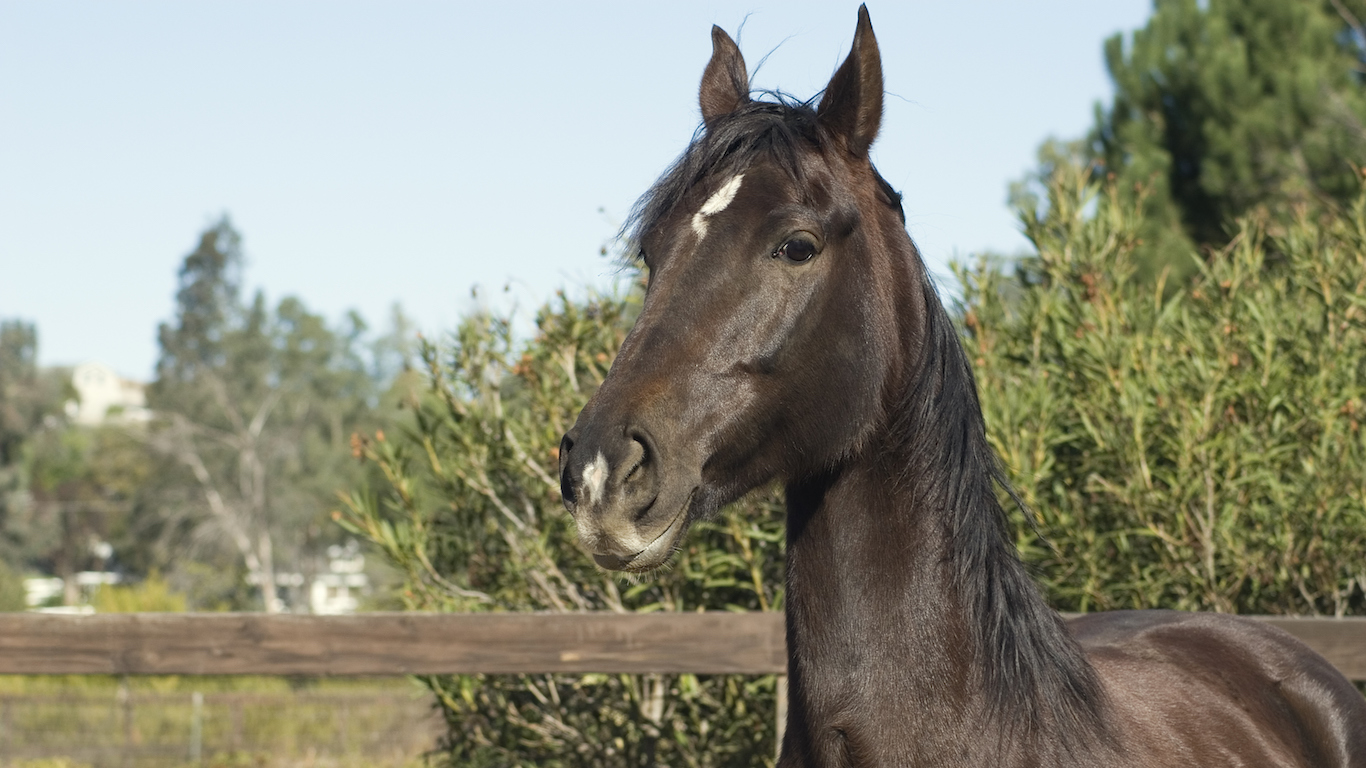
42. Tennessee
> State pet: Shelter pets
> State mammal(s): Raccoon, Tennessee walking horse
> State bird: Mockingbird, bobwhite quail
> State fish and aquatic life: Smallmouth bass, channel catfish
The Tennessee walker was the first breed of horse to bear a state name and has been the official state horse since 2000. As its name suggests, it’s known for its running walk, its flat foot walk, and its canter. The walker was developed by farmers in the Bluegrass region by combining thoroughbreds and other horses, including the Narragansett Pacer.
43. Texas
> State pet: Blue Lacy
> State mammal(s): Mexican free-tailed bat, American quarter horse, longhorn
> State bird: Mockingbird
> State fish and aquatic life: Guadalupe bass, Kemp’s Ridley sea turtle, Texas Gulf shrimp
The Blue Lacy became the official state dog of Texas in 2005. It was developed in the 19th century by the Lacy brothers of Burnet County. They wanted a dog with great herding abilities and crossed greyhounds, scent hounds, and coyotes. The Blue Lacy is a hard worker and is the most common breed used by trappers. It’s also a great pet and is good with children.

44. Utah
> State pet: N/A
> State mammal(s): Rocky Mountain elk
> State bird: California gull
> State fish and aquatic life: Bonneville cutthroat trout
The Rocky Mountain elk has been the official state animal of Utah since 1971. Elk were once found across the country but now live only west of the Rockies. Bulls can weigh over 1,000 pounds and have antlers 6 feet wide. Bulls grow a new set of antlers every year. New antlers are covered in fuzzy skin called velvet. They harden over the summer and become solid bone.
[in-text-ad-2]
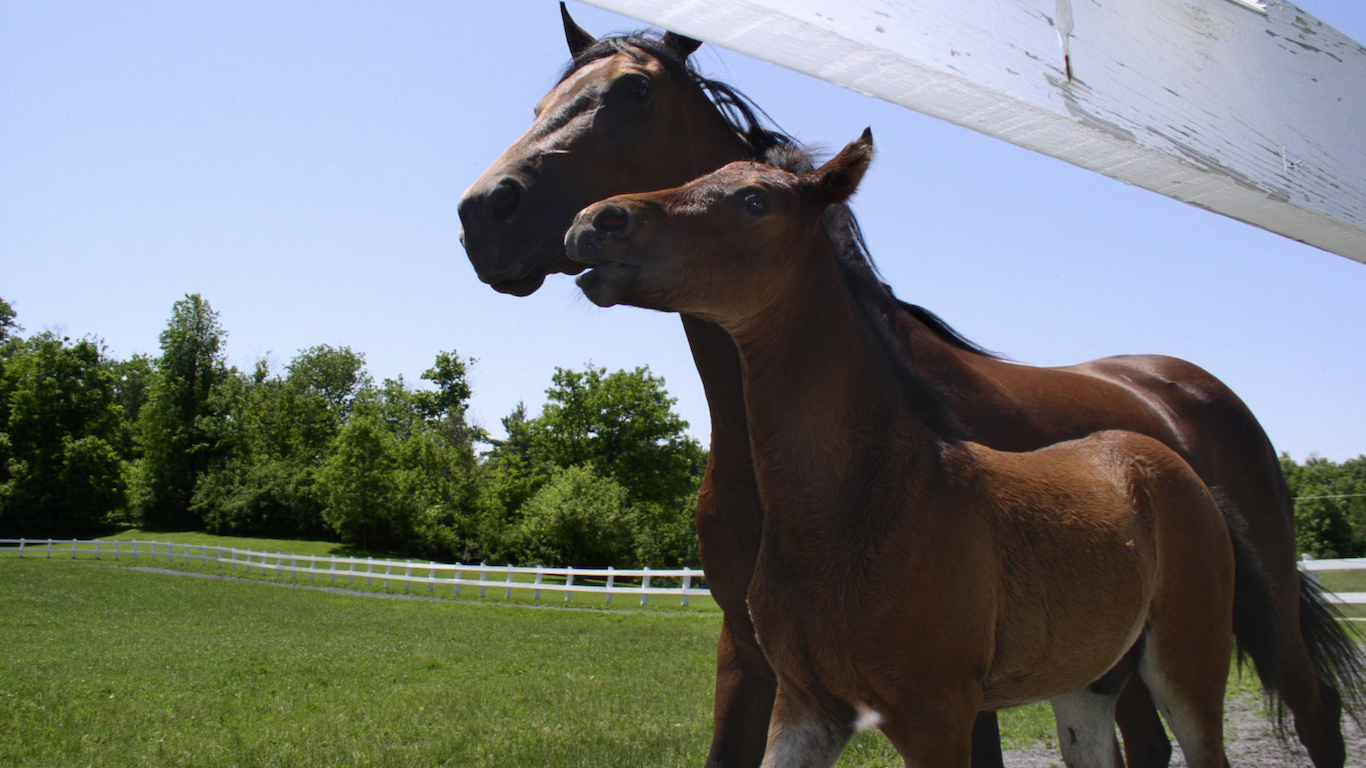
45. Vermont
> State pet: N/A
> State mammal(s): Morgan horse and Randall Lineback Cattle
> State bird: Hermit thrush
> State fish and aquatic life: Walleye, Brook trout
In the early 1800s, Justin Morgan owned a bay colt named Figure that became famous for his ability to outrun and outwork other horses and for being ridden by President James Monroe in 1817. Figure sired a number of horses, named for their father’s owner, that inherited his outstanding qualities, thus founding a breed that has become popular all over the world. The Morgan horse became the official state animal of Vermont in 1961.

46. Virginia
> State pet: American foxhound
> State mammal(s): Virginia big-eared bat
> State bird: Cardinal
> State fish and aquatic life: Striped bass, brook trout, oyster
The American foxhound, which was bred by Virginia planters to hunt foxes, has longer legs than its English cousin and namesake. George Washington, a keen foxhunter, was an important player in the dog breed’s development. It is a low-maintenance pet and is good with children and even cats. However, it can be difficult to call back when it gets on a scent.
[in-text-ad]

47. Washington
> State pet: N/A
> State mammal(s): Orca whale, Olympic marmot
> State bird: Willow Goldfinch
> State fish and aquatic life: Ostrea lurida, orca whale, steelhead trout
The orca was designated the official state mammal of Washington in 2005 at the urging of schoolchildren who wanted to raise awareness about the creature and help protect its habitat. Orcas migrate annually through Puget Sound and are a popular tourist attraction. Orcas are skilled and intelligent hunters — they are also known as killer whales — and can eat 500 pounds of food a day. There is even a horror film called “Orca”, about a male who seeks revenge for the killing of his mate.
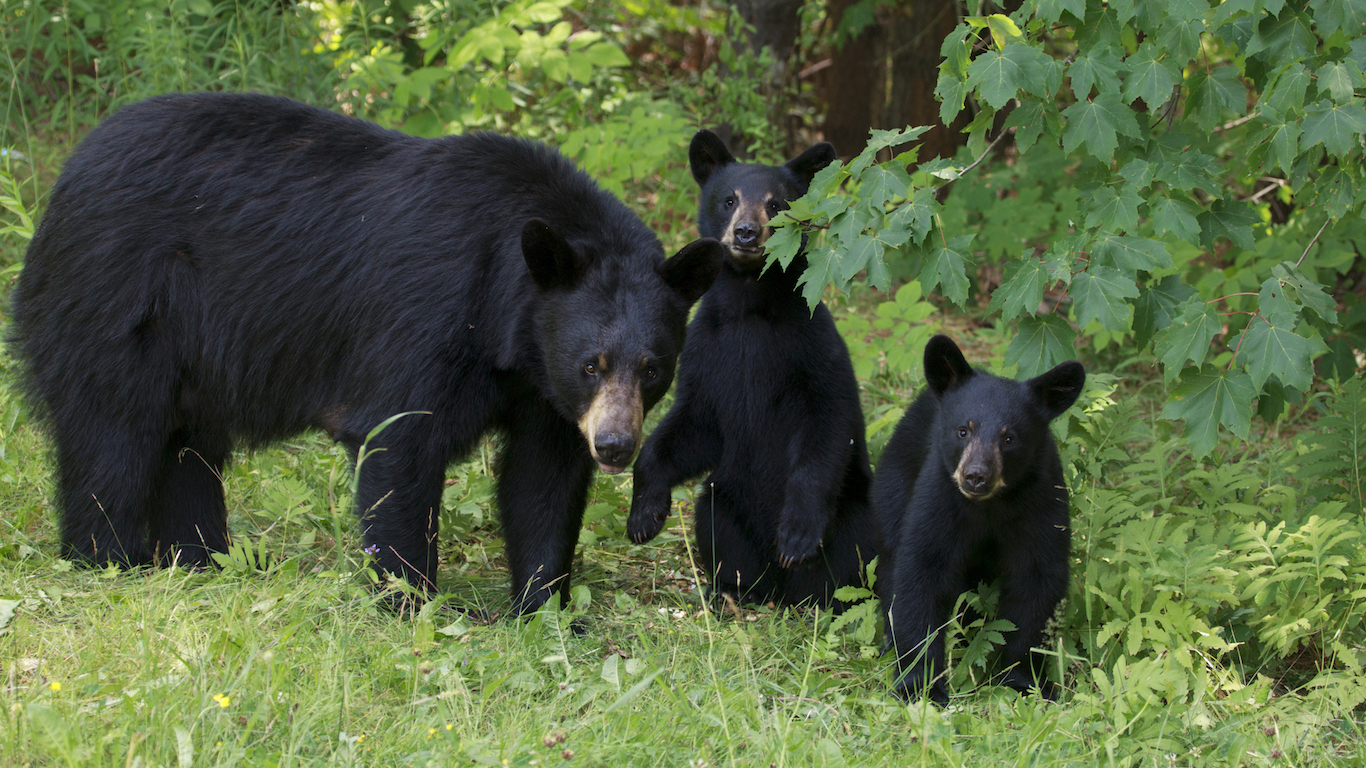
48. West Virginia
> State pet: N/A
> State mammal(s): Black bear
> State bird: Cardinal
> State fish and aquatic life: Brook trout
Like several other states, West Virginia’s state mammal is the black bear. It was chosen by a poll of students, teachers, and sportsmen in 1954 and won by a large margin. Since then, the population has increased steadily and black bears are found throughout the state. In 2014, West Virginia black bears was chosen as the name for a new Minor League Baseball team based in Granville and affiliated with the Pittsburgh Pirates.
49. Wisconsin
> State pet: American water spaniel
> State mammal(s): Badger, dairy cow, white-tailed deer
> State bird: American robin and mourning dove
> State fish and aquatic life: Muskellunge
The badger is the official state animal of Wisconsin, which happens to be nicknamed “The Badger State.” It also appears on the state flag and seal. Wisconsin also has an official domesticated animal, the dairy cow. Wisconsin is the country’s leading milk producer and is also known as “America’s Dairyland.”
[in-text-ad-2]

50. Wyoming
> State pet: N/A
> State mammal(s): American bison
> State bird: Western meadowlark
> State fish and aquatic life: Cutthroat trout
Wyoming is one of three states that have adopted the American bison, also known as the buffalo, as an official symbol. The majority of the bison herd is found in Grand Teton National Park during the summer and fall months. There are also some bison in the Jackson Hole area and the National Elk Refuge.
In 20 Years, I Haven’t Seen A Cash Back Card This Good
After two decades of reviewing financial products I haven’t seen anything like this. Credit card companies are at war, handing out free rewards and benefits to win the best customers.
A good cash back card can be worth thousands of dollars a year in free money, not to mention other perks like travel, insurance, and access to fancy lounges.
Our top pick today pays up to 5% cash back, a $200 bonus on top, and $0 annual fee. Click here to apply before they stop offering rewards this generous.
Flywheel Publishing has partnered with CardRatings for our coverage of credit card products. Flywheel Publishing and CardRatings may receive a commission from card issuers.
Thank you for reading! Have some feedback for us?
Contact the 24/7 Wall St. editorial team.

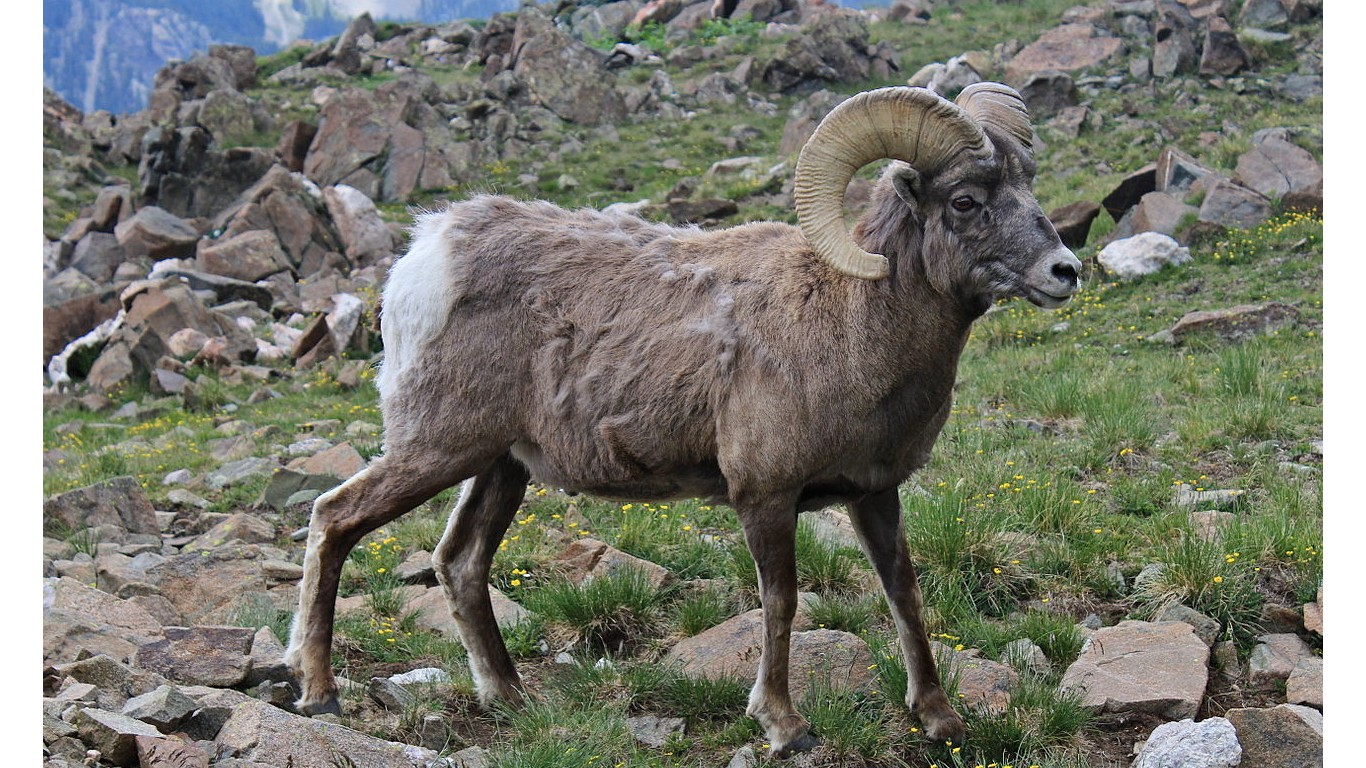
 24/7 Wall St.
24/7 Wall St. 24/7 Wall St.
24/7 Wall St.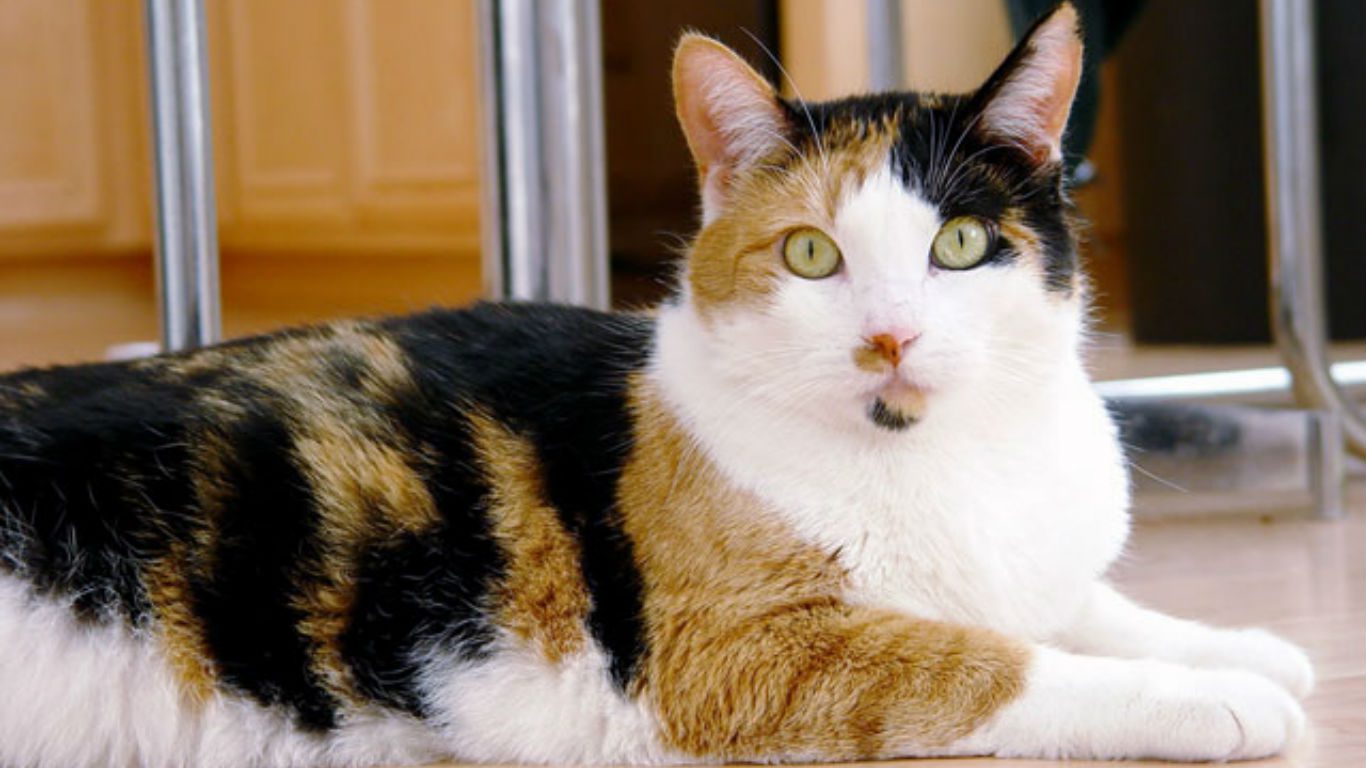
 24/7 Wall St.
24/7 Wall St.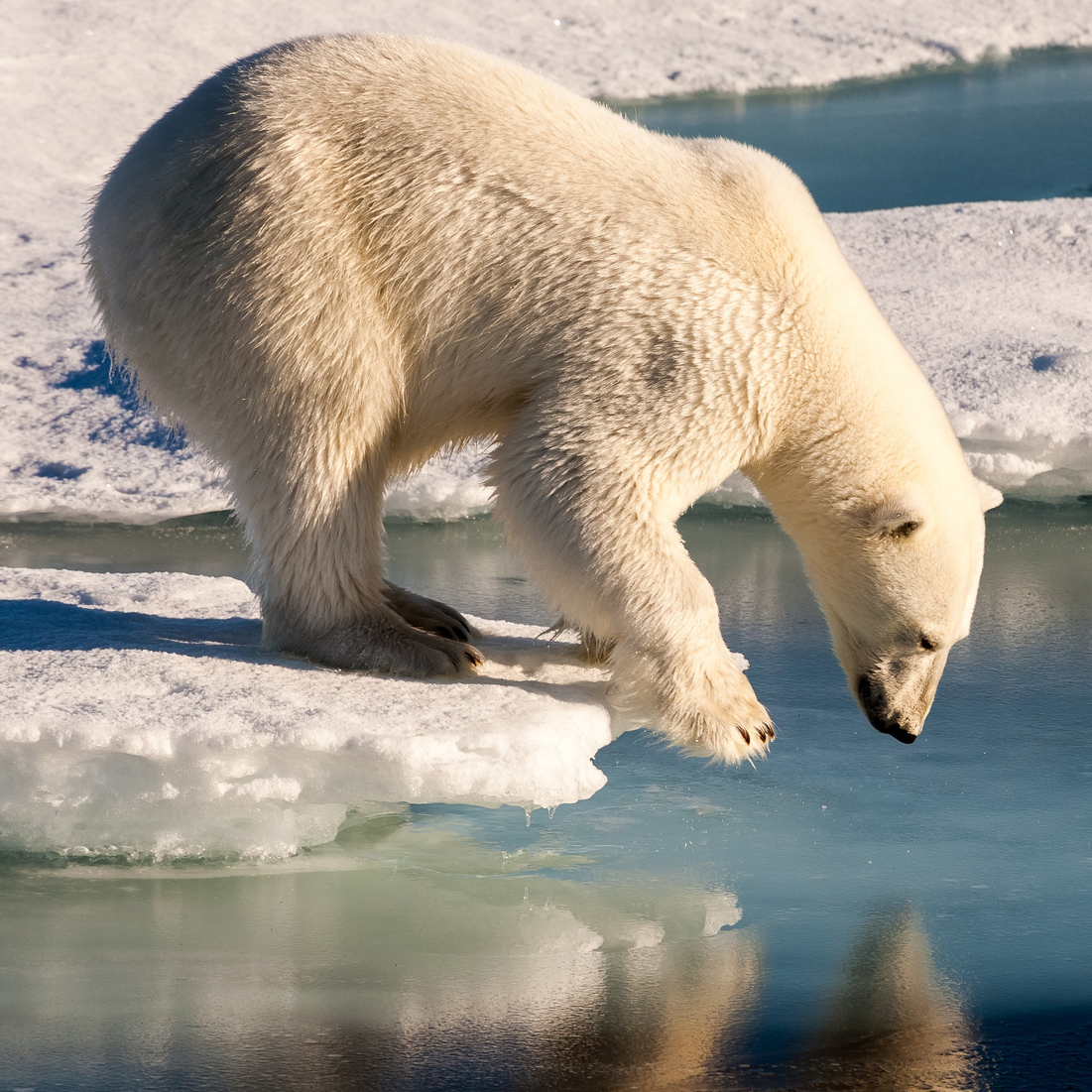 24/7 Wall St.
24/7 Wall St.
